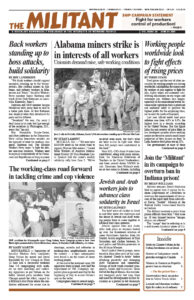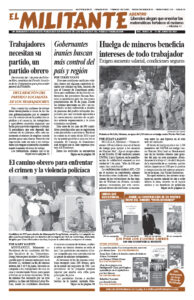Nationwide strikes and protests demanding jobs and an end to police attacks have paralyzed Colombia for almost two months. Tens of thousands of people took to the streets again June 2 after negotiations between the government and protest leaders stalled. The National Strike Committee, which includes Colombia’s main trade union federations, farmer associations, organizations of indigenous people, student groups and others, called a march on Bogotá, the country’s capital, for June 9, to press the government to rejoin talks.
The mass demonstrations were initially sparked by a tax reform proposed by President Iván Duque’s government that would have imposed new sales taxes on hard-pressed struggling working people. But the outpouring of pent-up popular outrage has continued even after Duque withdrew the proposals. Protesters are demanding the dismantling of the hated riot police force Esmad; a basic income; jobs, loans and subsidies for small farmers and small businesses; and free university tuition, among others.
Colombia’s economy, like in the rest of Latin America’s, registered sharp economic contractions in 2020, deepening the squeeze on working people that was already visible well before the pandemic. This has had devastating consequences for tens of millions of workers and peasants. Colombia’s official unemployment rate is more than 17%, climbing to over 20% in some cities. The share of Colombians between 14 and 25 years old who are neither working nor in school soared to 27.1% last year. Many of these urban working-class youth have been at the heart of the protests.
The government’s response to the demonstrations has been brutal repression. President Duque ordered the deployment of 7,000 troops to eight provinces May 28, claiming he was moving to help clear roadblocks set up by demonstrators that have impeded access to food, fuel and other goods. Over 1,100 soldiers were sent to Cali, the capital of Valle del Cauca province, an epicenter of the protests.
The Duque government has insisted all roadblocks be removed as a precondition for further negotiations. The strike committee has called on protesters to remove them, but many remain up. While there is majority sympathy and support for the protesters, growing numbers want to see the roadblocks dismantled to relieve the scarcity of food and other items they face.
The protests this year — which many consider a continuation of the national strike and mass mobilizations that took place in 2019 and 2020 — also reflect the widespread distrust and dissatisfaction with the capitalist political parties and “progressive” forces that claim to speak for working people in Colombia.
In the absence of a working-class leadership capable of harnessing this combativeness toward a fight for political power by the working class and its allies, and wrest concessions from the rulers along the way, other forces across the political spectrum seek to divert this discontent into next year’s presidential elections. This is a dead end for working people.
In addition to the deepening social and economic crisis of capitalism, exacerbated by the coronavirus epidemic, workers and farmers in Colombia confront the legacy of five decades of civil war.
A major aspect of the protesters discontent is the Duque government’s refusal to carry out the 2016 peace accord reached between the Colombian rulers and the FARC guerrillas. The government has reneged on promises to provide land and aid for former guerrillas. Political assassinations of trade union, peasant and indigenous leaders by thugs at the service of capitalist landowners, mining companies and drug lords have continued. Some 1,000 union, indigenous and peasant leaders have been killed since 2016.
Cuba’s role in peace talks
Cuba’s revolutionary government was instrumental in facilitating the peace agreement negotiations. Cuban leader Fidel Castro was a strong proponent of a negotiated end to the conflict, and a strong critic of the anti-working-class political course of the FARC, including rampant kidnappings and taking hostages.
“The civilians should never have been kidnapped, nor should the soldiers have been kept as prisoners in jungle conditions,” Castro wrote in 2008. “These were objectively cruel actions. No revolutionary aim could justify them,” he said, urging the FARC to release all remaining hostages.
Far from advancing the struggles of workers and farmers, the actions of the FARC were an obstacle. They pushed working people off to the sidelines, making it more difficult for them to develop class consciousness and gain confidence in their own capacity to mobilize in their millions against the capitalist rulers’ exploitation and oppression. The FARC carried out bombings, assassinations and kidnappings, which were used by the capitalist rulers and landowners as a pretext to clamp down on political rights.
The peace agreement set up a tribunal charged with investigating and prosecuting crimes committed during the conflict. FARC leaders admitted April 30 that it was their official policy to take hostages for ransom, to pressure the government to carry out prisoner exchanges, or to gain control of territory. Until then, FARC leaders had categorically denied this was their policy. Between 1990 and 2015, 21,396 people were kidnapped or taken hostage by the FARC, the tribunal has calculated.
The government uses these facts to try and undermine the peace agreement and to continue attacks and assassinations aimed at worker and peasant struggles.
The peace process, however, has opened up political space for protests and organization of working people. It has become more difficult for the government to portray working-class protesters as being fronts for the guerrilla groups.


